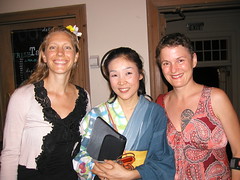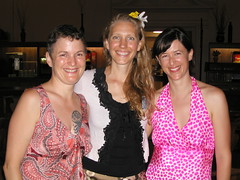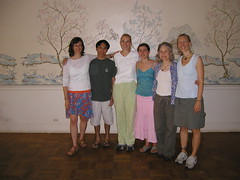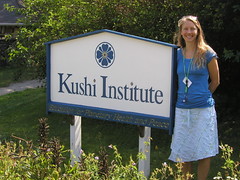The following release about gene activity pattern discovery was
sent to reporters under embargo on Wednesday. The embargo
lifted today:
Department of Health and Human Services
National Institutes of Health
National Cancer Institute
CONTACT:
NCI Media Relations Branch
(301) 496-6641
ncipressofficers@mail.nih.gov
Monday, August 14, 2006
5 pm EDT
Tumors Use ‘Hijacking’ Trick to Evade Attack by Immune Cells
Researchers have identified a potential mechanism by which tumors
in miceescape attack from antitumor immune cells. This escape is
facilitated when tumors produce a molecule called adenosine that
inactivates antitumor immune cells by binding to receptors on
their cell surfaces, the researchers found. Consequently, the
immune cells behave as though the tumors are normal tissue, and
an attack is averted. This research was conducted by scientists
at the National Cancer Institute (NCI) and the National Institute
of Allergy and Infectious Diseases (NIAID), both part of the
National Institutes of Health (NIH), and their collaborators.
Theresults are reported in the August 14, 2006, online issue of
Proceedings of the National Academy of Sciences*.
“This work may be complementary to efforts of cancer
immunologists who have developed many clever ways to improve the
development of antitumor T cells,” said NIH Director Elias A.
Zerhouni, M.D. “The cross-fertilization of research between the
field of immunology and cancer is a fruitful one that is paying
dividends with this new finding.”
“Tumors have hijacked a mechanism that evolved to protect
normal tissues from collateral damage that occurs when the body
mounts a defense against infection,” said lead researcher Misha
Sitkovsky, Ph.D., who until recently was at NIAID. Sitkovsky is
now at the New England Inflammation and Tissue Protection Institute,
a consortium at Northeastern University in Boston, Mass.
The findings extend research published in Nature in 2001 by
Sitkovsky and colleagues into the role of adenosine in regulating
inflammation. Inflammatory chemicals produced by the immune
system in response to infection or injury must eventually be
switched off so that excessive tissue damage can be avoided.
Sitkovsky and his colleagues have shown that one consequence of
inflammation -- a drop in oxygen levels in the inflamed
tissues -- triggers the release of adenosine from surrounding
cells and serves as atissue-protecting stop signal. This is because
when adenosine binds to so-called A2A adenosine receptors on
immune cells in the inflamed region, the production of
damaging inflammatory molecules is slowed.
In the new study, the researchers tested whether the same
mechanism protects cancerous tissues from antitumor T cells
by evaluating the effects of genetically deleting A2A adenosine
receptors in mice. The experiments showed that antitumor T cells
that lack A2A adenosine receptors can overcome tumor defenses and
eradicate tumor cells.
“We showed that if antitumor T cells do not express A2A
adenosine receptors due to a genetic deletion, then these antitumor
T cells can overcome adenosine-based tumor defense mechanisms.
As a result, the majority of these mice rejected their tumors and
survived significantly longer,” said co-researcher Scott Abrams,
Ph.D., of NCI’s Center for Cancer Research. By comparison, normal
mice that had antitumor T cells with intact A2A adenosine receptors
experienced uncontrolled tumor growth and died. Abrams added,
“These proof-of-concept experiments also raise the idea that this
type of tumor escape mechanism may serve as a target for
therapeutic intervention.”
To begin to explore that idea, the researchers pharmacologically
inactivated the A2A adenosine receptor using substances such as
caffeine and others to make antitumor T cells less susceptible
to inhibition by tumor-produced adenosine. The majority of mice
in these experiments had much better antitumor immune responses
and delayed tumor growth.
The genetic inactivation strategy was not effective in about 40
percent of the mice, however. The researchers suggest that one
reason may be the existence of other adenosine receptors in these
mice, and identifying these molecules will be a focus of future
research.
“Now we may be able to prevent a hostile tumor microenvironment
from inhibiting the antitumor T cells. I have been extremely
fascinated and puzzled by the paradoxical coexistence of tumors
and anti-tumor immune cells in the same cancer patient,” added
Sitkovsky. “I have been considering this contradiction for the
past 30 years.”
“Greater understanding of the tumor microenvironment and its
relationship to other cells in the body is not just enhancing
our knowledge of cancer; it could eventually lead to new treatments
and better ways to monitor those treatments,” said NCI Acting
Director John E. Niederhuber, M.D.
###
* Ohta A, Gorelik E, Ronchese F, Lukashev D, Prasad SJ, Wong MKK,
Huan X, Caldwell S, Liu K, Smith P, Chen JF, Jackson EK, Apasov S,
Abrams S, and Sitkovsky M. A2A adenosine receptor protects tumors
from anti-tumor T cells. PNAS. Online August 14, 2006.
The NIH -- The Nation's Medical Research Agency -- includes
27 Institutes and Centers and is a component of the U.S. Department
of Health and Human Services. It is the primary federal agency for
conducting and supporting basic, clinical and translational medical
research, and it investigates the causes, treatments, and cures
for both common and rare diseases. For more information about NIH
and its programs, visit www.nih.gov.
For more information about cancer, please visit the NCI Web site at
http://www.cancer.gov, or call NCI’s Cancer Information Service at
1-800-4-CANCER (1-800-422-6237).
NIAID supports basic and applied research to prevent, diagnose
and treat infectious diseases such as HIV/AIDS and other sexually
transmitted infections, influenza, tuberculosis, malaria and
illness from potential agents of bioterrorism. NIAID also supports
research on basic immunology, transplantation and immune-related
disorders, including autoimmune diseases, asthma and allergies.
Monday, August 14, 2006
Thursday, August 10, 2006
Dessert! Yum!
This picture shows a cous cous cake with a blueberry topping, a green tea mousse with an azuki bean topping and mochi dumplings, and a strawberry parfait with tofu whipped cream.
Recent meals
Here are some of the things I've cooked lately: red lentil loaf with sesame gravy, tempeh stew, and spinach ohitashi
Tuesday, August 08, 2006
Leslie, Mie, and Reni
Reni and I got to see our respected teachers Mie and Hiroyuki Naka at the KI Summer Conference. Here's beautiful and talented Mie. Does she look about 16 years old? She's 43!
Reni, Leslie, Paige
I'm so lucky to have two such wonderful macrobiotic friends. Thanks, Reni, for coming to visit, and thanks, Paige, for all the time we worked together!
Cooking Class Team
Paige (left) and I (right) co-managed a team of 8 cooking class volunteers. These were a few of our great team members, Kevin, Ceri, Barbara, and Anita. They helped us a lot doing a really demanding job.
Leslie at the Kushi Institute in Becket
This was my first ever trip to the KI. I was super exhausted after a week of working 12 to 17 hour days non-stop as the KI Summer Conference Cooking Class Team Leader. The reason for going up was to help put away the cooking utensils and food from the 5-day conference. It was great to be in Becket and to finally see what the KI is like. The food is sooo yummy!
A message from the KI Summer Conference
“Macrobios Global”
spoken by Michio Kushi on 7/29/2006 at the Kushi Institute Summer Conference
Michio’s Goals
1) Health recovery in the next 2 years. His ascending colon was 98% blocked which caused a water control problem for him. Since they removed part of the upward colon, where it was attached to his small intestine and appendix, this has been causing trembling and weakness in his legs. Left untreated, his condition could have led to a heart attack. His B-12 synthesis has been reduced and sometimes he requires shots. In the next couple of years, he’ll remain on a reduced schedule and try to recover his health. He said he’s been getting better and better all the time.
2) He’d like a comprehensive book of “Macrobios Whole View” or infinity from beginning of time to the end
3) He’d like a World Macrobiotic Federation with about 100 senior macrobiotic leaders from all over the world. The goals of this WMF would be to:
a. have 2 – 3 days of special studies with group tours between countries
b. hold more international events
c. have the countries/centers do their events (e.g., summer conferences) at different times to enable people to attend everything
d. make borders obsolete
e. create a world Constitution (i.e., Declaration of Independence-like document) and present to current world leaders in 2 to 3 years.
4) He’d like the current form of energy to change or to have another Industrial Revolution. At the moment, we’re using too much energy, digging too many minerals and oil, and burning too much oil, causing extensive pollution. The additional developing countries are now adding to this pollution. We need to avoid more global warming, and he makes this a 10-year goal. We need a new energy source such as:
a. the energy of Earth’s rotation
b. the transmutation of atoms from the 8 light elements into heavier elements
5) We need to recognize our ultimate purpose of having a spiritual and peaceful human kind, and practice self-love and love towards others. Religion, in his estimation, is not making a definite contribution to peace. The focus should be removed from the physical and instead should be refocused on more developed spiritual and mental states. He estimates this will take approximately 2000 years to accomplish. Health should overcome violence, sickness, and conflict, creating a new civilization.
While Michio is still alive, he plans to teach more. One example of this would be to teach a new type of visual diagnosis. For example, currently, each part of the face represents a different organ. Another way to do this is to take the whole face to read each organ. Specifically, if you’re looking at a woman’s face and wanting to diagnose the reproductive system, the eyes represent the ovaries, and the area around the eye represents the fallopian tubes. The nose is the uterus, and just below the nose is the cervix, the lips the vagina, and around the mouth is the endometrium. Another example is the lungs; the right side of the face is the right lung, and the left side the left lung, respectively. He’d like to be able to teach several styles of visual diagnosis to us all.
He wants a teacher’s health curriculum.
He thanks everyone for the work they have been doing and though he may not remember names, he remembers faces.
spoken by Michio Kushi on 7/29/2006 at the Kushi Institute Summer Conference
Michio’s Goals
1) Health recovery in the next 2 years. His ascending colon was 98% blocked which caused a water control problem for him. Since they removed part of the upward colon, where it was attached to his small intestine and appendix, this has been causing trembling and weakness in his legs. Left untreated, his condition could have led to a heart attack. His B-12 synthesis has been reduced and sometimes he requires shots. In the next couple of years, he’ll remain on a reduced schedule and try to recover his health. He said he’s been getting better and better all the time.
2) He’d like a comprehensive book of “Macrobios Whole View” or infinity from beginning of time to the end
3) He’d like a World Macrobiotic Federation with about 100 senior macrobiotic leaders from all over the world. The goals of this WMF would be to:
a. have 2 – 3 days of special studies with group tours between countries
b. hold more international events
c. have the countries/centers do their events (e.g., summer conferences) at different times to enable people to attend everything
d. make borders obsolete
e. create a world Constitution (i.e., Declaration of Independence-like document) and present to current world leaders in 2 to 3 years.
4) He’d like the current form of energy to change or to have another Industrial Revolution. At the moment, we’re using too much energy, digging too many minerals and oil, and burning too much oil, causing extensive pollution. The additional developing countries are now adding to this pollution. We need to avoid more global warming, and he makes this a 10-year goal. We need a new energy source such as:
a. the energy of Earth’s rotation
b. the transmutation of atoms from the 8 light elements into heavier elements
5) We need to recognize our ultimate purpose of having a spiritual and peaceful human kind, and practice self-love and love towards others. Religion, in his estimation, is not making a definite contribution to peace. The focus should be removed from the physical and instead should be refocused on more developed spiritual and mental states. He estimates this will take approximately 2000 years to accomplish. Health should overcome violence, sickness, and conflict, creating a new civilization.
While Michio is still alive, he plans to teach more. One example of this would be to teach a new type of visual diagnosis. For example, currently, each part of the face represents a different organ. Another way to do this is to take the whole face to read each organ. Specifically, if you’re looking at a woman’s face and wanting to diagnose the reproductive system, the eyes represent the ovaries, and the area around the eye represents the fallopian tubes. The nose is the uterus, and just below the nose is the cervix, the lips the vagina, and around the mouth is the endometrium. Another example is the lungs; the right side of the face is the right lung, and the left side the left lung, respectively. He’d like to be able to teach several styles of visual diagnosis to us all.
He wants a teacher’s health curriculum.
He thanks everyone for the work they have been doing and though he may not remember names, he remembers faces.
Subscribe to:
Comments (Atom)





